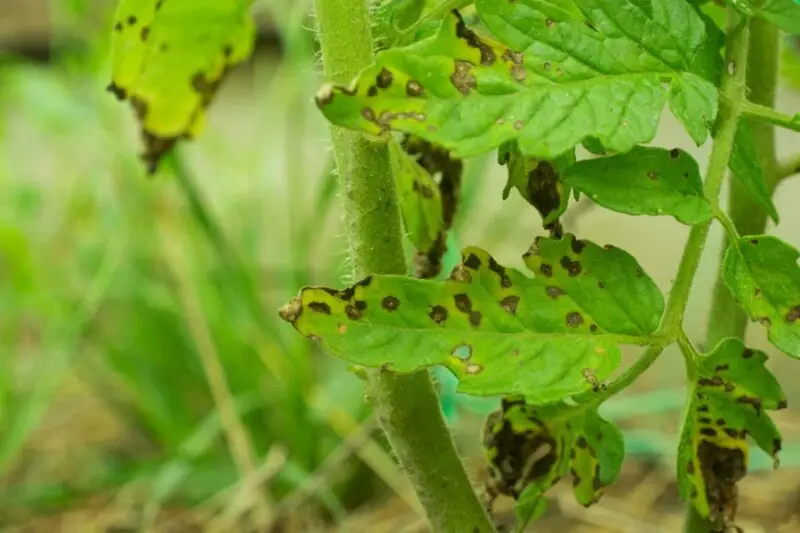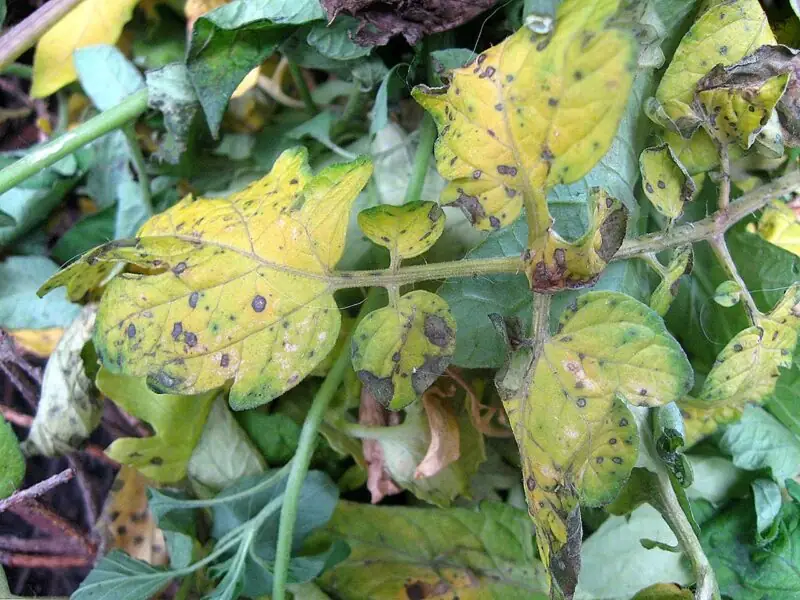Identify and Control Septoria Leaf Spot on Tomatoes: Effective Strategies

Overview of Septoria Leaf Spot
Step into the world of tomato gardening, and you’ll soon meet a common nuisance – septoria leaf spot on tomatoes. This fungal disease, caused by the fungus Septoria lycopersici, targets the foliage of tomato plants. When the first symptoms appear, you’ll notice water-soaked spots on the lower leaves. The disease soon reveals itself fully as these spots enlarge, develop gray or tan centers with dark brown edges, and the affected leaves turn yellow and fall off. The fungus overwinters in infected plant debris and soil, resurging when conditions are warm and damp. Understanding this enemy is the first step to a healthy, bountiful tomato harvest.
Importance of Disease Management in Tomato Plants
Managing this disease of tomato plants is very important. It involves an integrative approach from planting your seedlings to the end of the growing season. Simple steps like watering plants early in the day, removing infected leaves, or cleaning up tomato debris can significantly reduce disease prevalence. These practices keep septoria and other diseases under control, ensuring your tomatoes grow healthy and fruitful.
Understanding the Septoria Lycopersici Pathogen
The Pathogen: Septoria Lycopersici
Septoria lycopersici is behind the mischief of these brown spots plaguing your precious tomatoes. This pathogen has a knack for survival, lying dormant in plant debris and soil, awaiting the right conditions to strike. The fungus begins producing spores in warm and wet conditions. These fungal spores can spread through splashing water, carrying the disease from plant to plant.
Solanaceous Plants and Their Susceptibility to Septoria Leaf Spot
The world of solanaceous plants, which includes tomatoes, is, unfortunately, no stranger to this menace. Tomato plants are particularly susceptible to the disease, but it can also affect other members of the family, like horsenettle and black nightshade. The fungus can even overwinter these plants, ready to attack your tomatoes when the growing season arrives and high humidity is more common.
Recognizing Septoria Leaf Spot on Tomatoes
Leaf Spots on Tomato: First Signs of Trouble
The early signs of an infection are easy to ignore. The lowest leaves and stems begin to develop tiny, wet patches. These are the first indications of the impending invasion of the garden menace called septoria. As they grow, their centers eventually turn gray or tan and their margins finally take on a dark brown hue. Learn how to identify the problem in its early stages, and you’ll have an easier time dealing with these circular spots.
Specific Symptoms of Septoria Leaf Spot
The symptoms get clearer as the condition gets worse. The fungus’s fruiting bodies, or pycnidia, which resemble tiny, black pinpricks, appear in the center of the spots. As the illness progresses, the spots congregate, turning the leaves yellow and eventually causing them to fall off. If you notice these signs, it’s time to start enacting good management practices.
Comparing Septoria Leaf Spot and Other Tomato Diseases
Septoria Leaf Spot vs. Early Blight
It’s important to distinguish septoria leaf spot from other diseases like early blight. While both diseases cause spots, early blight spots often have a bullseye-like appearance with concentric rings, unlike the uniform tan centers of septoria. Moreover, early blight tends to affect the entire plant, not just the leaves. Knowing the difference can help ensure the right treatment for your ailing tomatoes.
Differentiating Leaf Spots in Tomato Plants
There are various diseases that might create tomato leaf spots, but they’re all different from one another. For instance, to distinguish them from other illnesses, septoria leaf spots contain pycnidia in the middle and gray or tan centers with dark brown margins. Recognizing these signs can help you swiftly identify and address the issues in your garden.
Treating Septoria Leaf Spot

Use of Fungicide for Septoria Leaf Spot Control
Fungicides, especially those that contain chlorothalonil, are one of the typical treatments to halt the spreading of the disease. Fungicide spraying on your plants can help manage the disease, but be sure to adhere to the product’s label directions. Applying fungicide frequently when it’s wet will help prevent instances of plants infected with septoria.
Organic Approaches for Treat Septoria Leaf Spot for Organic Growers
For those who prefer organic methods, there are other options available to help the common tomato plant. One effective practice is removing and disposing of infected leaves as soon as symptoms appear. Additionally, maintaining proper plant spacing can improve air circulation, helping leaves dry faster, preventing humid conditions, and making it less hospitable for the fungus. Employing these techniques can help keep your tomatoes healthy without resorting to chemical treatments.
Preventing Septoria Leaf Spot
Best Practices to Prevent Septoria Leaf Spot
Prevention is always better than cure, and that’s true for bodies of the fungus on tomatoes as well. Start by selecting resistant varieties. Next, practice crop rotation, ensuring you don’t plant tomatoes in the same spot where the infection occurred in the previous year. Also, water early in the day, and focus on lower leaves and stems to minimize leaf wetness. And don’t forget to regularly clean up plant debris to eliminate potential overwintering fungal spores.
Disease Management Techniques for Tomato Plants
In the long run, a successful gardening experience hinges on disease management. This means not just reacting to symptoms but implementing preventive measures. Proper plant spacing can improve air circulation, making it harder for this fungus to establish itself. Regular inspection of your plants can help you catch the disease early, nipping the problem in the bud before it gets out of hand.
Frequently Asked Questions
Septoria lycopersici s caused by a fungus. It spreads through splashing water, which can disperse the fungal spores from infected plants or soil onto healthy plants.
Absolutely! With good gardening practices such as proper irrigation, regular removal of diseased plant debris, and use of resistant varieties, you can this issue quite effectively.
Yes, it is possible to manage septoria leaf spots organically. Infected leaves should be removed and disposed of, plant spacing should be maintained for optimum air circulation, and watering should be done early in the day to reduce leaf wetness. Symptoms usually point towards a greater problem, so plan accordingly.
Conclusion
With all this information, you’re now equipped to take on septoria leaf spot on tomatoes. Remember, the key is to understand the disease, spot its symptoms early, and follow recommended practices for treatment and prevention. Your effort to manage this fungus not only ensures healthier plants but also contributes to a more fruitful harvest. Happy gardening!